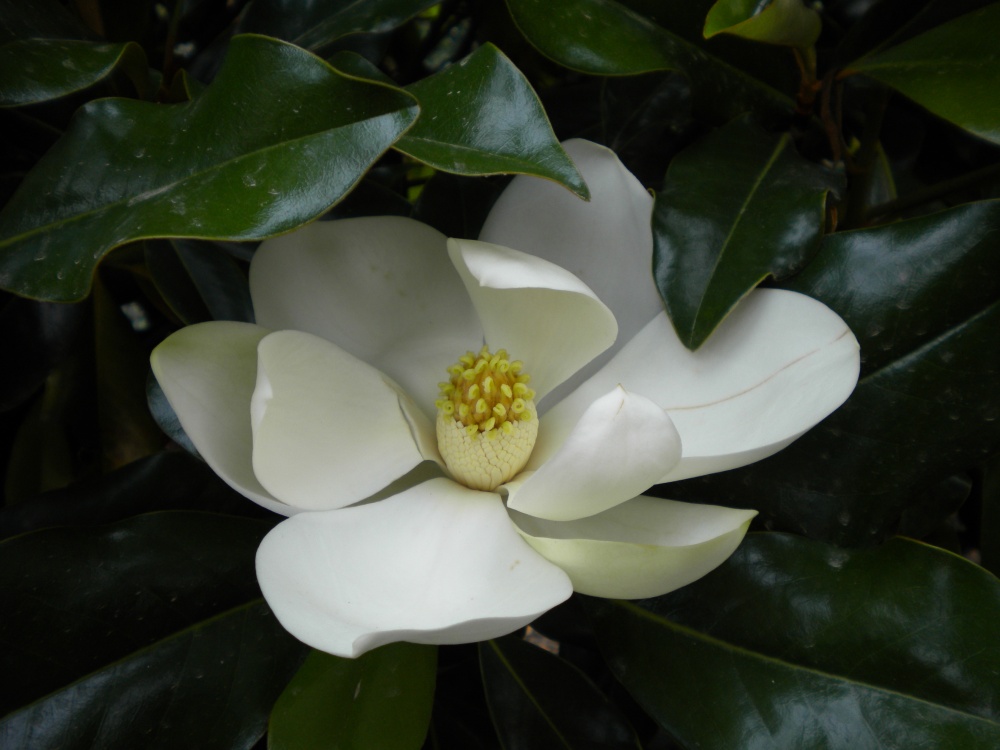Over two winters the three Southern magnolias (Magnolia grandiflora, below in bloom) in the garden were beaten and battered by snow. The main trunk of ‘Bracken’s Brown Beauty’ was broken once in the heavy snow of 2010, and more damage was inflicted in the wet snow a year later. While the trunk of ‘Greenback’ was spared, many of its upright growing branches were shattered. ‘Alta’ was damaged only slightly in the heaviest snow, but it lost a few small branches to the wet snow, and this year a lower branch was snapped, I presume due to deer rubbing against it.
These have been difficult years for the magnolias, but each spring the trees have bounced back to cover their injuries with new growth. The ‘Brackens’ magnolia is hardly half as tall as it was a few years ago, but now it’s twice as wide. Rather than having a broad pyramidal form, it’s now short and squat, a huge evergreen shrub. The other magnolias barely show signs of the damage.
I briefly considered chopping out the two worst of the magnolias when I was cleaning up other storm damage, but they are in relatively inconspicuous spots (to me) along the neighbor’s property line, so I left them. I know that many gardeners consider the evergreen magnolias to be messy and a nuisance, but my garden is perpetually messy enough that the leathery fallen leaves aren’t a bother, so I’m happy that I reconsidered cutting them out.

There’s been mixed success with other snow damaged evergreens. Nandinas that were laid flat quickly perked up, though a few stray branches arched a bit more. A few of these partially obstructed stone paths in the garden, so my wife has pruned them to the ground. Boxwoods and hollies sprang back into shape soon after the snow melted, and the holes left by broken branches quickly filled back in.
Bent branches of upright growing arborvitae and junipers were bound with nylon straps, and after a few years some have regained their form and a few haven’t. One ‘Gold Cone’ juniper (Juniperus communis ‘Gold Cone’, above) regained its shape, but a second was more severely damaged, was chopped in half in a desperate attempt at salvage, and now will be cut out since it failed to shape up. ‘Gold Cone’ barely shows any gold color at all in the heat and humidity of Virginia, so it will hardly be missed.
To look around the garden only the most critical eye would be aware of the damage, and I’ve discovered that I can look over, around, or through a less than desirable specimen for however long it takes for it to be presentable again. If this was a more public garden with more frequent visitors I might be more concerned, but probably not. Plants will repair themselves to a surprising extent if some patience (or laziness) is exercised.
The more recent wind storm wreaked havoc on two deciduous magnolias that suffered multiple broken branches and a Seven Son Tree that was snapped off at the base. The Seven Son tree is gone, cut up into pieces, but the magnolias will require some repair. The Dr. Merrill magnolia has lost the top fifteen feet of one of two trunks, and the Bigleaf magnolia (Magnolia macrophylla, above) has a number of smaller branches that have broken. Some remain suspended far up into the tree, where they will stay until the wind blows them down some day. Watch out below!
Dr. Merrill will require some surgical repair, but the damage to the Bigleaf magnolia is too far up in the tree to reach, so it will have to heal on its own. Oh well, both trees are surrounded by other trees, and I suspect that in another year I’ll barely notice.